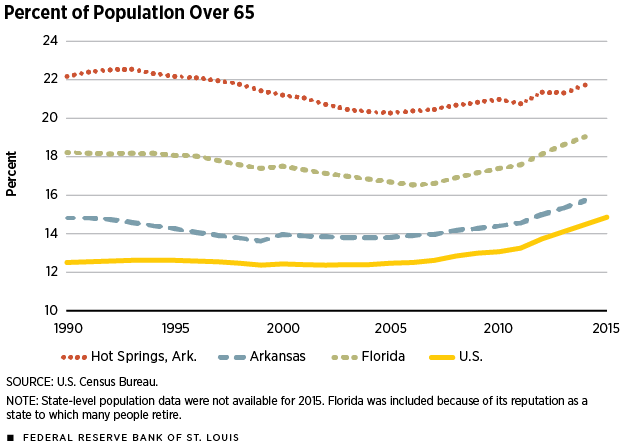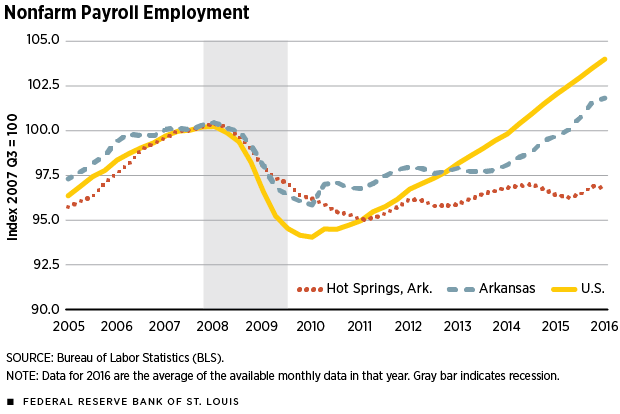Health Care, Hospitality and Retirees Keep Hot Springs Afloat
Located in central Arkansas, the Hot Springs metropolitan statistical area (MSA) is named after the numerous natural hot springs that can be found in the region, including those at Hot Springs National Park. The springs and surrounding area attract millions of visitors to the MSA every year. Indeed, tourists played an integral role in the area’s early development and continue to shape the region’s economy and demographics today.
The MSA is comprised of a single county—Garland—and in 2015 had a population of 97,177. It is one of the smaller MSAs in the nation and accounts for only 3 percent of the Arkansas population. Population growth in the previous five years was 1.2 percent, a little more than half of the state’s growth of 2.1 percent.
The regional economy produces about $3 billion in goods and services each year, as measured by gross metropolitan product (GMP). Economic growth has averaged 3.9 percent per year over the past five years. This is faster than the state’s average growth rate of 1.8 percent and the national rate of 2.1 percent for that period.
The median household income in Hot Springs is about $40,000, which is $1,000 less than the state median income. These figures mask the greater inequality in Hot Springs compared with that of the state overall. The share of households in Hot Springs earning less than $15,000 a year is 18.4 percent, compared with 16.6 percent for the state. On the opposite side of the coin, 3.5 percent of Hot Springs’ households earn about $200,000, compared with the state’s 2.9 percent. This level of inequality in Hot Springs is likely due to its industrial and demographic composition.
Health Care and Hospitality
Of the 40,000 workers employed in Hot Springs in 2014, about 60 percent were employed in one of three sectors: health services (21 percent); trade, transportation and utilities (20 percent); and leisure and hospitality (18 percent). While the employment share of the trade, transportation and utilities sector is reflective of the nation’s, the employment share of health services and of leisure and hospitality is, respectively, 1.4 and 1.7 times larger in Hot Springs than in the nation overall. In 2014, the average annual income in leisure and hospitality was about $15,000. In health services, it was $40,000. This difference in income, combined with the large employment share in each sector, can partially explain the higher level of income inequality in Hot Springs.
The disproportionate size of the leisure and hospitality sector, relative to the rest of the country, should not be surprising, considering more than 2 million people annually visit a region of fewer than 100,000 residents. These visitors spent close to a quarter of the region’s GMP in 2014 and accounted for the bulk of tax revenue for the region. Almost 1.5 million of these tourists visit the national park. The other major attraction in the region is Oaklawn, a horse race track and casino and the second largest employer in the region.
The abundance of leisure activities is not only ideal for tourists, but it makes Hot Springs an attractive location for retirees. About 22 percent of the region’s population is over 65, well above the national average of about 15 percent. (See Figure 1.) While the U.S. is experiencing a general demographic shift toward an older population, Hot Springs has consistently featured a higher share of older residents.
This demographic makeup also explains the importance of the health services sector in the MSA, as older people generally need more of these services.
Typically, an older population is accompanied by lower tax revenue and lower population growth. Given that most of the area’s tax revenue comes from visitors, the former likely is not a concern for Hot Springs. However, the lower rate of population growth already seems to be occurring in the data.
After the Great Recession
Although the Great Recession (2007-2009) ended seven years ago, the Hot Springs MSA has still not fully recovered from its impact on local employment. Figure 2 shows the evolution of the nonfarm payroll employment for the U.S., Arkansas and the Hot Springs MSA. The decline in Hot Springs’ employment during the recession was much more protracted than the state or national decline, and the MSA’s recovery started a year after the Arkansas recovery began. What is perhaps most striking is that employment has not yet returned to its prerecession levels in Hot Springs despite state and national recoveries.
It is instructive to consider which sectors might be holding back a full recovery in Hot Springs. The table shows the changes and levels in employment before, during and after the most recent recession and features two salient findings. First, the scant recovery that did take place in Hot Springs was led by the leisure and hospitality sector and by health services,1 reinforcing the importance of these two sectors for the area. Second, the lack of a full recovery is largely due to a sluggish recovery in the construction sector.
While the recession disproportionally impacted the construction sector throughout the U.S., the housing market has generally been on the rebound and the construction sector is adding jobs. A recovery in construction is not yet apparent in Hot Springs, as the sector has struggled to create jobs with new projects in the region. Several business contacts noted that the area’s geography is not particularly well-suited to large construction projects, and this factor may play a role in the lack of a rebound in that sector.
Outlook
A consequence of a large leisure and hospitality sector is that the short- and long-term economic outlook of the MSA is highly dependent on the number of visitors to the area. The lack of a major airport in the area means that many visitors drive to Hot Springs for their vacations and most are from neighboring states.2 Contacts in the area report that the economic growth in Texas is being felt in Hot Springs through a high volume of visitors from the state. While Hot Springs may regularly benefit from the short-term booms of neighboring economies, it is also exposed to their busts.
Hospitality-driven areas should be wary of households’ intentions to take a vacation and, perhaps more importantly for Hot Springs, their intention to drive for a vacation. Figure 3 shows these intentions, and it highlights a long-term decline in the percentage of households reporting that they intend to take a vacation within the U.S. This decline is mirrored in households’ intentions to drive for a vacation. While Hot Springs has enjoyed steady increases in the annual number of visitors in the recent past, these changes in household sentiment may pose a longer-term risk for the MSA.
Figure 1

Figure 2

Figure 3

Private Employment before, during and after the Great Recession
| Sector | Employment in 2007 | % Change, 2007 to 2010 | % Change, 2007 to 2014 | Change in Employment 2007-2014 |
|---|---|---|---|---|
| Construction | 2,414 | –33.5 | –37.6 | –756 |
| Manufacturing | 2,715 | –30.2 | –11.7 | –299 |
| Professional and business services | 3,371 | –5.6 | –8.4 | –271 |
| Trade, transportation, and utilities | 7,471 | –3.1 | –3.1 | –227 |
| Financial activities | 1,533 | –10.9 | –7.1 | –105 |
| Natural resources and mining | 370 | –13.3 | –24.4 | –80 |
| Other services | 969 | –0.6 | –2.3 | –22 |
| Information | 419 | –23.0 | 20.6 | 96 |
| Leisure and hospitality | 6,383 | –1.7 | 2.3 | 146 |
| Education and health services | 7,121 | 3.9 | 6.0 | 442 |
| Total, all industries | 32,765 | –6.0 | –3.3 | –1,075 |
SOURCE: Quarterly Census of Employment and Wages, Bureau of Labor Statistics (BLS).
MSA Snapshot
Hot Springs, Ark.
| POPULATION |
97,177
|
| POPULATION GROWTH (2010-2015) |
1.2%
|
| PERCENTAGE WITH BACHELOR'S DEGREE OR HIGHER | 21% |
| PERCENTAGE WITH A HS DEGREE OR HIGHER |
86.9%
|
| PER CAPITA PERSONAL INCOME |
$23,514
|
| MEDIAN HOUSEHOLD INCOME |
$39,558
|
| UNEMPLOYMENT RATE (MAY) | 4.1% |
| REAL GMP (2014) | $3.132 BILLION |
| GMP GROWTH (2014) | 1.55% |
Largest Employers
| CHI St. Vincent—Hot Springs |
1,700
|
| Oaklawn |
1,368
|
| Wal-Mart Stores (3 stores) |
1,026
|
| National Park Medical Center |
653
|
| City of Hot Springs |
591
|


Endnotes
- Only 1 percent of total employment in the education and health services sector in the MSA is actually in education. [back to text]
- The chamber of commerce reported that in 2013 just over 30 percent of all visitors were from one of five states: Illinois, Louisiana, Missouri, Oklahoma and Texas. Twenty percent of visitors were from Arkansas. [back to text]
Views expressed in Regional Economist are not necessarily those of the St. Louis Fed or Federal Reserve System.
For the latest insights from our economists and other St. Louis Fed experts, visit On the Economy and subscribe.
Email Us


